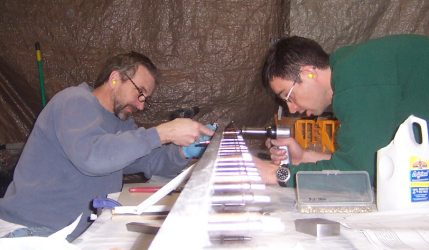I had ordered and received replacement crankshaft-connecting rod bearings. Dan and I took a couple hours to put the compressor back together. Dan had some STP type stuff to put in the bearings during assembly. We put the flapper plates back together, bolted it all together, filled it with oil, put the fly wheel on, and …. it works and it is much more quiet. So far so good. The worn bearings must have been rattling around.
Spar Laminate Hole Drilling 1
Dan and I discussed at length (remember we are engineers) how to mark all the holes on the 141″ long W10-01. We have a 12″ and 36″ steel rules supposably accurate rked to the 1/64 . So one could start at one end and make a make a mark near the end of the rule and move the rule down to that mark and keep going. Trouble with this method is “accumulation of error” or “error stack up”. Say you are off by 1/64 (.015″) on the first rule move, and then the second move is right on, but the third is another 1/64 (.015″), and the fourth is another 1/64 off. (Now before you repremand me to be more accurate, try to mark and then reposition to a 1/64, it’s take time and a good set of eyeballs.) Anyway the holes on your fourth ruler interval are off by the accumulated errors since they are all dependent on the previous set. So those holes are off by 3/64″ (.045″), hmmmmm. Does it matter? I don’t know, but would like to be as accurate as we can.
So when we thought about going 141″ we wanted to try something different. We decided to make a drill template and move the template along the spar (picking up the last hole drilled by the template.) We made the template the distance between the ribs which is 10″. Now the error will depend on the accuarcy of the template, but we have access to a Bridgeport mill at work so we used that for the hole accuracy. So basically the template had the rib holes 10″ apart and all the 1″ holes in between. We put flange on one side so it would mate against the spar top (or bottom) and the holes would be the the right distance. Here is a picture of the template:
We had marked the 10″ intervals with the rule also, but the template would be the guide. Now that we had the top and bottom holes of the ribs, we made another drill template for the rib holes in between. This template was cleco-ed to the top and bottom and provided the middle holes
We went back with the first template and drilled the holes between teh ribs:
Now that is a lot of holes.
We drilled the holes for the wing tip attachment, W10-04. Aligned the top edge and the right length.
We used the first template for the top holes:
Here is the angle, W10-06 on the wing tip attachment W10-07:
Spar Mating holes layout
The left and right front spars overlap as can be seen in W08 Detail K. In the overlap region there are 5 accurate holes that line up. If you look later in the plans only the outside two bolt the two spars together. The middle three are used as alignment holes when you drill the outside ones to each other and the fuselage. When making the main spar webs, W10-01 the plans note to layout and drill these hole accurately.
So given the accuracy of marking and then drilling what is the likelihood that all 5 sets of holes will line up exactly. Well Dan and I discussed this at length and this is what we came up with. Any two sets of holes will define the two spar webs and the rest of the holes will just over constrain the parts. Think of it this way, you overlap the two spars as shown in the plans, you put a pin in one set of the 5 holes that line up. Now you cannot move the two spars in X and Y directions the only degree of freedom left is rotational. So now you can rotate the spars until another set of the 4 holes (that are left) are aligned. Put a pin in those two aligned holes. Now the two spars are fully constrained to each other and if the final 3 sets of holes line up GREAT, but if they don’t there is nothing you can do about it. Given the accuracy of marking and drilling it is easy to be off by a 1/64 of an inch, which is .015″. Now on a #40 hole (.098″ dia) that 64th of an inch is 15% and will be noticeable by eye. But that is in just one direction (X) you could be off in the other (Y) also.
Now I know that these holes will be up drilled at a later date so maybe it doesn’t matter. But here is what we did. We drilled the two outside holes of the 5 “wing attach” on each spar web as accurately as we could. We then flipped one spar round and clecoed them together as they are layed out in the final assembly using the outside holes. Now we match drilled the 3 middle holes through the two webs. Now all 5 sets of hole will line up since the middle 3 were “aligned” by the outside 2.
Are we over thinking this? Probably. Are we engineers? Yup.
Here are the two spar webs aligned by the two outside clecos
Here we are checking the angle:
Checking the overlap on the bottom:











